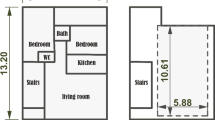Abstract
For the first time, the impact of indoor air distributions on the thermal and power performances of single layer semi-transparent photovoltaic (SL-STPV) facades was investigated in this study. A novel two-dimensional steady-state heat transfer model for SL-STPV facades was developed and experimentally validated, which is capable to simulate the operating temperature of PV modules in non-uniform thermal environment, and then evaluate the power generation capacity as well as the heat gain of SL-STPV facades for building-integrated applications. In addition, the thermal and power performances of SL-STPV facades were numerically investigated for two typical indoor air distribution systems, named displacement ventilation (DV) and mixing ventilation (MV) systems. The results revealed that the indoor air distribution slightly influenced the average operating temperature of PV module, but greatly affected the heat gain of SL-STPV facades. The heat gain of SL-STPV facades in DV system was reduced 11.7%, in compared with that in MV system. Thus, the DV system is suggested to be adopted in buildings installed with SL-STPV facades, to achieve a better overall energy performance.
Similar content being viewed by others
References
Cheng Y, Niu J, Du Z, Lei Y (2015). Investigation on the thermal comfort and energy efficiency of stratified air distribution systems. Energy for Sustainable Development, 28: 1–9.
Fung TYY, Yang H (2008). Study on thermal performance of semitransparent building-integrated photovoltaic glazings. Energy and Buildings, 40: 341–350.
Gan G, Riffat SB (2004). CFD modelling of air flow and thermal performance of an atrium integrated with photovoltaics. Building and Environment, 39: 735–748.
Han J, Lu L, Yang H (2009). Thermal behavior of a novel type seethrough glazing system with integrated PV cells. Building and Environment, 44: 2129–2136.
He W, Zhang YX, Sun W, Hou JX, Jiang QY, Ji J (2011). Experimental and numerical investigation on the performance of amorphous silicon photovoltaics window in East China. Building and Environment, 46: 363–369.
Jelle BP (2016). Building integrated photovoltaics: A concise description of the current state of the art and possible research pathways. Energies, 9: 21.
Kapsis K, Athienitis AK (2015). A study of the potential benefits of semi-transparent photovoltaics in commercial buildings. Solar Energy, 115: 120–132.
Pei G, Ji J, Jiang A, Zhou T, He W (2009). Performance analysis of PV double-glazed window. Acta Energiae Solaris Sinica, 30(4): 441–444. (in Chinese)
Peng J, Lu L, Yang H, Han J (2013). Investigation on the annual thermal performance of a photovoltaic wall mounted on a multilayer façade. Applied Energy, 112: 646–656.
Peng J, Lu L, Yang H, Ma T (2015). Comparative study of the thermal and power performances of a semi-transparent photovoltaic façade under different ventilation modes. Applied Energy, 138: 572–583.
Skoplaki E, Palyvos JA (2009). On the temperature dependence of photovoltaic module electrical performance: A review of efficiency/power correlations. Solar Energy, 83: 614–624.
Smolec W, Thomas A (1993). Theoretical and experimental investigations of heat transfer in a trombe wall. Energy Conversion and Management, 34: 385–400.
Tao W (2001). Numerical Heat Transfer, 2nd edn. Xi’an: Xi’an Jiaotong University Press. (in Chinese)
Yoon J-H, Shim S-R, An YS, Lee KH (2013). An experimental study on the annual surface temperature characteristics of amorphous silicon BIPV window. Energy and Buildings, 62: 166–175.
Zhu L (2007). Research on the performance of technology about photovoltaic facades and technology application in Shenzhen. PhD Thesis, Chongqing University, China. (in Chinese)
Acknowledgements
The authors appreciated the financial support from the National Natural Science Foundation of China (No. 51408391, No. 51528804 and No. 51808372). The work was also supported by Scientific and Technological Innovation Programs of Higher Education Institutions in Shanxi (No. 201802046) and Application Foundation Research Plan of Shanxi Province (No. 201801D221348). The Opening Funds of State Key Laboratory of Building Safety and Built Environment and National Engineering Research Center of Building Technology (No. BSBE2018-02) was also acknowledged.
Author information
Authors and Affiliations
Corresponding authors
Rights and permissions
About this article
Cite this article
Yang, J., Cheng, Y., Jia, J. et al. The impact of indoor air distributions on the thermal performance of a single layer semi-transparent photovoltaic facade. Build. Simul. 12, 69–77 (2019). https://doi.org/10.1007/s12273-019-0516-6
Received:
Revised:
Accepted:
Published:
Issue Date:
DOI: https://doi.org/10.1007/s12273-019-0516-6




